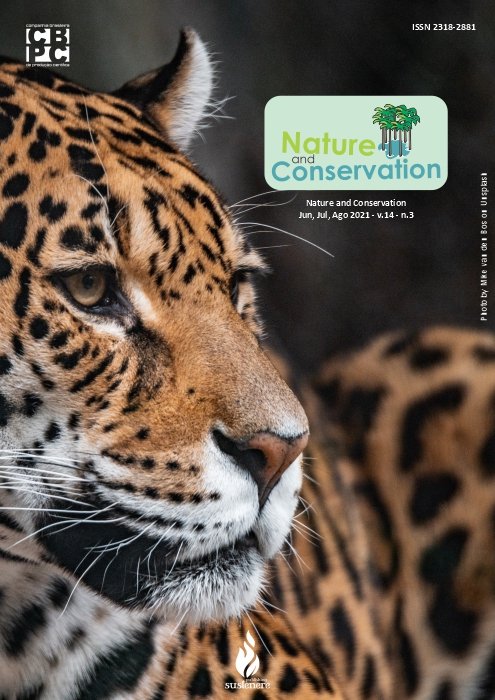The relationship of rain to water recharge in an urban spring in Santarém-PA, Amazônia, Brazil
DOI:
https://doi.org/10.6008/CBPC2318-2881.2021.003.0007Keywords:
Precipitation, Groundwater, Fluviometric Level, Groundwater RechargeAbstract
The recharge of springs´ water is directly influenced by rainfall and by the integrity of the riparian forest and the channel. Variations in the rainfall pattern, such as a decrease in volume, and the presence/absence of riparian vegetation can affect water recharge. To verify the influence of the rain in a spring area with riparian vegetation in recovery, in a stream in the urban area of Santarém-PA, rainfall, water table level and fluviometric level were monitored at three points, between November 2017 and September 2019. There was a statistically significant difference between the monitored points for the water table level (F=19.4; p=4.3x10-7), the fluviometric level (F=16.02; p=3.9x10-6) and the water recharge (F=5.75; p=0.005), as well as between the rainy and dry periods, for the values of the water table level (F=4.9; p =0.03) and fluviometric level (F=5.34; p=0.02). The average annual recharge for the year 2018 at the spring area was 22% and for the year 2019 it was 28%. Rainfall was positively correlated with the fluviometric level (R²=0.54, p=0.02) and negatively with the water table level (R²=-0.77, p=0.002). During the period of 22 months of monitoring, it was possible to observe that in the rainy period the fluviometric level was on average 36 cm and in the dry period it dropped to 26.4 cm, with a difference between the periods of 9.8 cm. The mean water table level recorded in the rainy season was 31 cm below the ground, and in the dry season there was a lowering in the water table to 44 cm below the ground (difference of -13 cm). The recharge of water at the Irurá stream spring in the rainy season was 22% (905.6 mm) and in the dry season it was 63% (334.9 mm), which shows that more than 60% of the rain that falls during the dry period is used to recharge the spring. This characteristic indicates that the infiltrated groundwater effectively supplies this water table and provides its variability. The depth of the water table was relatively shallow, and the seasonal variation of the fluviometric level was like the results found in Amazonian dry land (terra-firme) streams, in the three monitored points in the riparian zone of the Irurá stream spring area. The annual water recharge values found in this study for the Irurá stream spring area, obtained by applying the Water Level Variation (VNA) method, are close to those of free and deep aquifers in the Amazon. The results demonstrate that the water table varies seasonally, according to the rainy season, and spatially, as there was a difference between some monitored points due to their location before or after areas where there are anthropic interventions in the channel, such as damming. The natural reforestation process that has been progressive over 45 years, combining a mixture of secondary forest with remnants of primary vegetation favors the recharge of water and the maintenance of the spring. The municipality of Santarém is made up of a dense network of streams, which are under strong impact due to disorderly urban expansion. The monitoring of groundwater and surface water resources carried out in this study are important to verify how changes in groundwater influence the amount of water available to forests, maintenance of streams, society and instigate watershed conservation actions.
Downloads
Downloads
Published
Issue
Section
License
Copyright (c) 2021 Nature and Conservation

This work is licensed under a Creative Commons Attribution-NonCommercial-NoDerivatives 4.0 International License.
The CBPC - Companhia Brasileira de Produção Científica (Brazil CNPJ: 11.221.422/0001-03) the material rights of the published works. The rights relate to the publication of the work anywhere in the world, including rights to renewals, expansions and dissemination of the contribution, as well as other subsidiary rights. All electronically published works may subsequently be published in printed collections under the coordination of this company and / or its partners. The authors preserve the copyright, but are not allowed to publish the contribution in another medium, printed or digital, in Portuguese or in translation.









